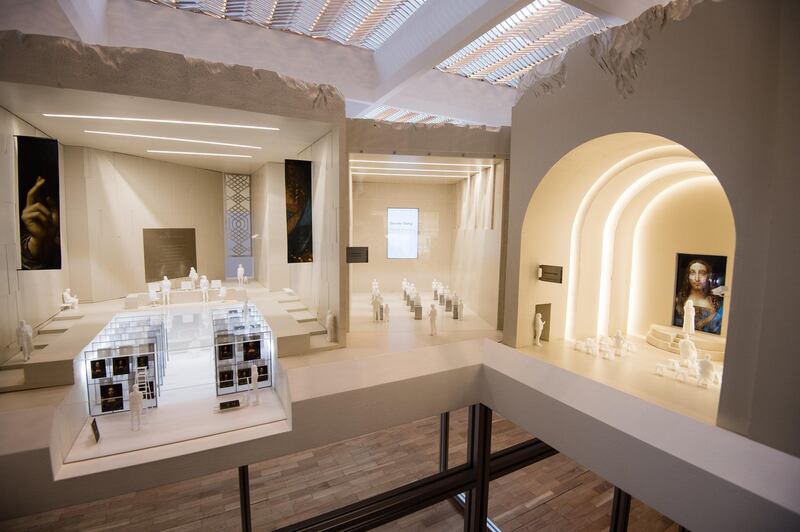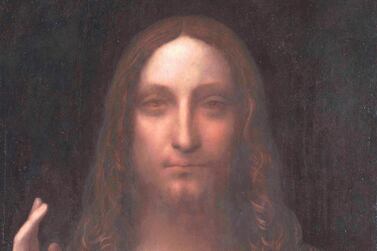The Salvator Mundi is the subject of a new show in London. London-based artist Simon Fujiwara and David Kohn Architects have built an "experience museum" for the painting as part of a London exhibition, complete with miniature Salvator Mundis on display.
Visitors, one at a time, duck under a mastaba-like white structure. When they emerge inside, they see suites of miniature galleries, made on a 1:24 scale, in which different iterations of the painting are displayed. One gallery shows rows of the portrait in perspex boxes; another in which Leonardo’s Christ figure, digitally rendered, mouths imperceptible words to an audience of 2D cardboard figures.
"Authenticity and humanity itself are dwindling resources as we become more technological — they are the last bastion of something precious," says Fujiwara, a UK artist who investigates the display values of art and artefacts.
“This work is nostalgic for a time when artists and architects made artwork. Now, it’s just an experience.”
Invited by the Whitechapel Gallery for a re-make of their famous show This Is Tomorrow (the new exhibition is titled Is This Tomorrow?), Fujiwara and Kohn became fascinated by the painting, intrigued by a marketing campaign and a string of articles in the press that have made it one of the most famous artworks of its time. They planned a trip to Abu Dhabi to see it, but before they could get there, Louvre Abu Dhabi announced that the display of the painting was being delayed.
"Then it became even more interesting," says Kohn, who has worked with the V&A and the ICA in London on their galleries. He sees the relationship between the painting and Louvre Abu Dhabi as part of a larger, age-old connection between the museum and the artworks it holds. "We found that you didn't even need the painting for its very presence to permeate everything. It's like the Mona Lisa: the painting is almost better known than the Louvre."
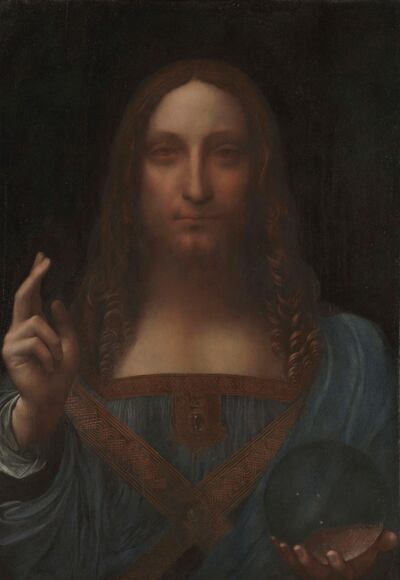
“Architecture suffers because it can’t be human enough,” he continues.
“But a face — we are hardwired to know a face above all things. It’s the first thing we see, it’s the first thing we fall in love with. And architecture cannot compete. If you introduce something of that potency into an architectural context, you have to know that its capacity is to totally overwrite the hierarchies that preceded it. That’s what it’s done, and that’s what it was hoped to do. The presence of the painting is there, because it’s part of the story now.”
The art experience
Fujiwara and Kohn responded to the painting’s outsized importance by bringing in another facet of contemporary museum-going: that of the “experience”, such as the Van Gogh experience that toured last year to Abu Dhabi and Dubai. In this phenomenon, not the actual artworks, but digital projections of artwork, alongside images from the artist’s life, are projected in enormous warehouses and sites to create an immersive walk-through of an artistic practice.
“I thought, is this the best I can hope for as an artist?” says Fujiwara. “Digital renderings of my work? I’m not saying they’re good or bad — they’re a historical phenomenon. As things become rarer, the way we want to maximise them becomes bigger.”
In the Salvator Mundi Experience, as part of the larger exhibit, the interior is suffused with overwrought music — in fact, the score is the same one Christie's commissioned when it made a teaser video of the painting before it was auctioned (for $450 million).
That video itself is playing, also in miniature, in one of the museum’s galleries. As is the case for many museums nowadays, each room is named after its benefactor — which is not a gimmick. The cost for the mini-museum overran the budget Fujiwara and Kohn were given by the Whitechapel, and they had to ask collectors to help realise their idea.
A canonical show revisited
The artist’s and architect’s interdisciplinary collaboration was a crucial part of the Whitechapel’s show, again mimicking the original This Is Tomorrow, when architects, painters, and sculptors all worked together to create projects.
When it opened in August 1956, it was enormously popular, reportedly hosted a thousand visitors a day, and it helped introduce a new language of art-making to post-War Britain: most notably British Pop, with its critiques of new consumerism.
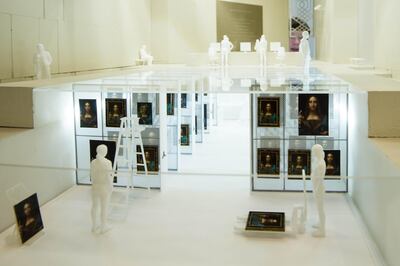
“At the time, this part of London was still a bomb site,” says Iwona Blazwick, the Whitechapel’s director, about the original show.
“There were ruins everywhere, little to eat, life was black and white. Artists said that they’d had enough and decided to look instead towards the future. The gallery invited architects and artists to say, ‘this is the future’.”
The show helped launch the Independent Group, made up of Richard Hamilton, Eduardo Paolozzi, John McHale, and others.
Hamilton debuted his poster, Just What Is It that Makes Today's Homes So Different, So Appealing?, which remains endlessly referenced, and elsewhere artists questioned how science and technology could become new parts of everyday life.
The Whitechapel’s decision to revisit the show is less on an anniversary basis —the curator, Lydia Yee, conceded that “63 years isn’t exactly a round number” — but because of the social and political temperature of the UK at the moment.
“Right now there’s unprecedented uncertainty, in terms of the political sphere, the economy, and the environment,” she says. “It felt like the right time to question what the future is."
Yee paired artists with architects to pose answers to this question, and the replies oscillate between being upbeat and depressing, with the latter — perhaps inevitably — winning out.
It opens on an enormous animal pen that visitors are invited to go through, in a collaboration between the artist Amalia Pica and the London-based 6a architects that highlights the contradictory stance towards animal welfare.
"We wanted to get across a sense of sadness about animals as well as a sense of joy," Pica explains. "Like you love your pet, but still eat lamb." The work, Enclosure, is intended for single animals, and contains the odd pet toy, but still feels claustrophobically small as you wend through; I felt more sadness than joy.
The corral chimes nicely with a piece upstairs by the artist Zineb Sedira and Farshid Moussavi Architecture, which simulates the dark, heavy revolving doors that regulate movement in airports, stadiums, amusement parks and construction sites. (Yee points out that revolving doors evolved from animal management systems.)
Surveillance and technology are key themes elsewhere; one of the most mind-boggling artworks is a collaboration between the professor of experimental architecture Rachel Armstrong and artist Cecile B Evans, who created a colony of microbes that generates energy.
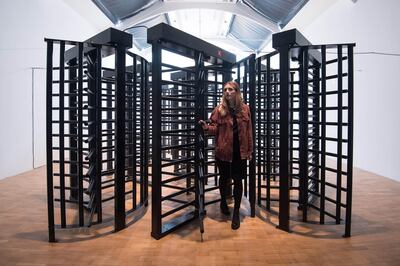
A moment of hope came in the form of a cathedral-like aperture, lined with soft colours and a gentle texture, made by artist Rana Begum, in collaboration with Bangladeshi architect Marina Tabassum. The pair were inspired, they say, by the Bait Ur Rouf, the light-filled mosque that Tabassum designed in Dhaka.
“What drives people is hope,” Tabassum says. “How do we think about tomorrow? We create a a space for contemplation, where from the ashes hope will rise about the difficulties the world is facing today.”
Is This Tomorrow? runs from February 14 to May 12 at the Whitechapel Gallery, London
